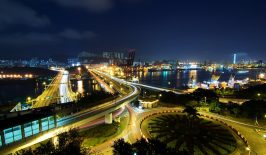In the year 1800, only two percent of the world’s population lived in urban areas. By 1900, that number had increased to nearly 13 percent, and in the year 2000, the percentage of of people residing in urban areas reached 47 percent. According the United Nations’ ‘World Urbanisation Prospects‘ report, in 2018 more than 55 percent of the world’s population lived in cities. By 2050, up to 68 percent of the world’s population is expected to live in urban areas. This surge towards urbanisation is, generally speaking, currently occurring at a higher rate in developing countries than in developed nations.
What’s Driving Urban Growth?
It is difficult to pinpoint exact causes of urban growth, both in terms of physical land area and population size, and apply them universally. When discussing urban land expansion (the process whereby the planet’s surface is configured for urban uses), for example, a Meta-Analysis of Global Urban Land Expansion study found that growth in GDP per capita was highly influential upon urban land expansion in China and North America whereas this was less so the case in India, Europe and parts of Africa (where population growth plays a much larger role in urban land expansion).
It is generally believed that the boom in urbanisation is strongly linked to economic growth, industrialisation and the perception of better employment prospects. The United Nations views cities as drivers of economic and human development and argues that “a critical mass of people, ideas, infrastructure and resources acts as a magnet of development, attracting migrants, private firms, investors and developers. All of this enhances the prospects for more employment opportunities, wealth creation, innovation and knowledge, which are all major factors of prosperity.” While this may certainly be the case in some areas, it does not have a blanket effect. An article in The Guardian analysed and compared the role urbanisation plays in economic development in parts of Asia and sub-Saharan Africa, finding that urban growth had benefited the former’s economy far more than in the case of the latter.
Get Smart: the Need for Integrated Urban Design
Packing a growing number of people into the world’s cities puts an enormous strain on available resources and sees emissions in urban areas skyrocket. According to the UN, cities consume 78 percent of the world’s energy and produce more than 60 percent of greenhouse gas emissions. Yet, they account for less than 2 percent of the Earth’s surface.
This trend towards an increase in the population in urban areas, coupled with the polarised economic growth (where global cities are responsible for over 65 percent of overall GDP growth), our rising reliance upon digital technologies in our daily lives and the need to decrease greenhouse gas emissions (GHGs) is what’s pushing forward the need for so-called ‘smart cities’, meticulously-planned urban areas that incorporate digital infrastructure to promote accessibility, eco-friendliness, resource efficiency and safe management of an influx of residents.
What Are Smart Cities?
Due to the complexity of how cities are regulated, financed, planned and operated, there is currently no fixed definition for “Smart Cities”; however, the concept can be described as the process by which cities and urban areas become more efficient, livable and environmentally friendly. In other words (those of the Community of Practice Digital Cities to be precise), “a city can be considered as ‘smart’ when its investment in human and social capital and in communications infrastructure actively promote sustainable economic development and a high quality of life, including the wise management of natural resources through participatory government”.
A 2013 study by Harvard University economist Edward L. Glaeser found that while there is an overall correlation between economic and urban development, cities that support urbanisation with appropriate and adaptive policies, institutions and strategies fare far better than those that don’t.
Depending on the situation, a smart approach to city planning may include some of the following elements:
- The use of modern efficient, and intelligent infrastructures such as smart energy grids and effective waste management, etc;
- A thoughtful approach to integrating information and communications technologies that support and enhance day-to-day urban life;
- Urban design that is accessible and citizen centric with great emphasis on the role of public participation;
- Adaptive urban design that accomodates new and existing residents and where city planners can learn from experiments and create new models;
- Transparency, where all citizens have access to data from city services and establishments; and
- Adaptation of pro-active city-wide policies, which give city authorities the tools to implement smart city programmes.
As mentioned earlier, there are various factors and actors involved in the development of Smart Cities. The majority of the current models for smart development recognise the following six as the main elements in smart city design:
- Citizens: availability of proper education and training, e-learning with an all-encompassing emphasis on inclusion and social cohesion
- Mobility: consideration for public transportation, Information and communications technology (ICT) infrastructure and availability of public internet access
- Management: promotion of ICT in public services such e-voting, e-governance, public transparency
- Economy: government support for entrepreneurship and creativity through financial promotion, diffusion of ICT in local business
- Environment: active and adaptive response to environmental concerns
- Quality of Life: access to e-health and effective health services
Urban and climate strategist Boyd Cohen refines this even further with his Smart Cities Wheel, breaking up the concept of smart cities into distinct six components, each with three sub-components: Smart Economy, Smart Environment, Smart Governance, Smart Living, Smart Mobility, and Smart People. Consulting firm Frost and Sullivan (who themselves identify eight components as essential to smart cities) predicts that by 2025, 26 cities around the globe will be classified as ‘smart’ (i.e. meeting five or more of their eight criteria) with half of these to be located in North America and Europe.
Recent Developments in Smart City Design
Proposals for smart cities are cropping up in certain regions across the world – in Brazil, Norway, North America – as are a number of national and international programmes related to the promotion of smart cities. One of the most well-known proposals was the European Union’s (EU) initiative on smart cities, also known as the “European Innovation Partnership for Smart Cities and Communities”. Between 2014 and 2020, the European Regional Development Fund allocated 15 billion EUR on “strategic partnerships between industry and European cities to develop the urban systems and infrastructures of tomorrow”.
The initiative provided financial support as well as strategic advice to European cities to assist governing bodies in shifting city development towards so-called ‘smarter’ horizons. The EU’s broader, overall approach to making its cities more energy-efficient, inclusive and climate adaptive is structured around the following aims:
- strengthen research, technological development and innovation;
- enhance access to, and use and quality of, ICTs;
- enhance the competitiveness of small to medium enterprises and the agricultural sector;
- support the shift towards a low-carbon economy in all sectors;
- promote climate change adaptation, risk prevention and management;
- protect the environment and promote resource efficiency;
- promote sustainable transport;
- promote employment and support labour mobility;
- promote social inclusion and combat poverty;
- invest in education, skills and lifelong learning; and
- enhance institutional capacity building and efficient public administrations.
It was replaced by the 2021-2027 Cohesion policy legislative framework with a total budget of 392 billion EUR.
One of the main objectives of the EU’s initiative is ‘energy efficiency first’ principle and that the level of greenhouse gas emissions arising from the project is consistent with the climate neutrality objective in 2050. The implementation of such a goal requires ambitious measures in regards to the design of transportation and energy networks and buildings.
Cities in North America, South America and Asia are also adopting smart principles to drive their cities towards efficient, tech-integrated futures. San Francisco is already renowned for promoting e-mobility, providing more than 900 charging stations for hybrid and electric cars as well as being home to ride-sharing giant Über; Seattle has placed huge emphasis on smart metering and energy conservation, assisting residents in configuring their homes to be more energy resourceful and showing them how to track and manage their own energy consumption; Rio de Janeiro has set up an integrated transport system that improves mobility in slums in the Rio Maré area; and Seoul uses innovative means of catching data to give real time updates on the city’s traffic.
Smart City Case Study: Copenhagen, Denmark
Over the last ten years, Copenhagen, through its ambitious vision for smart development, has become a leader in the smart city movement.
On the environmental front, Copenhagen has set lofty goals for itself and is implementing some well-craft plans to meet them. The Danish capital, home to more than 1.2 million people, is determined to become the first carbon neutral capital by the year 2025. The city has already began to implement various innovative strategies to revolutionise:
- water management: encompassing everything from establishing a foundation dedicated to supporting eco-friendly technological breakthroughs in water quality and availability to creating a benchmark for the last amount of water used to brew beer (Carlsberg);
- energy: the Copenhagen Cleantech Cluster looks to attract companies looking to test clean technologies in a real urban setting;
- heating: 80 percent of Denmark’s heat is recovered from electricity stations while the rest comes from waste incineration, biomass and renewable sources;
- and transport systems, including smart approaches to city cycling infrastructure.
Copenhagen’s robust digital infrastructure has undoubtedly facilitated its shift towards becoming a smart city. The Copenhagen Wheel, developed by the MIT SENSEable Lab and Ducati, is a project that transforms normal cycles into hybrid e-bikes that provide feedback on local pollution levels, traffic, road conditions and even allows users to lock and unlock their bikes using their smartphones.
Copenhagen’s smart city approach is based on two very important strategies. First, through careful planning, the city has turned itself into a ‘living-lab’ for sustainable green urban experiments (such as that by the Copenhagen Cleantech Cluster outlined above). The creation of the new sustainable neighborhood of Nordhavn (40,000 residents) is a perfect example of this measure. Second, the “sharing is caring” attitude of the city, coupled with its openness towards digital solutions and clean technology, has allowed it to become a hub for new technological advancement in the field of smart city design.
This article was originally published on 10/31/2014. It has since been updated on 04/26/2022 by Marharyta Biriukova.











